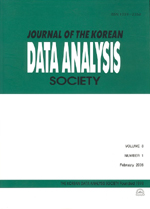중도절단회귀모형을 이용한 한국의 육류수요분석
An Analysis of Meat Demand System in Korea using Censored Regression Model - An Almost Ideal Demand System Approach
- 한국자료분석학회
- Journal of The Korean Data Analysis Society (JKDAS)
- Vol.9 No.6
-
2007.122889 - 2901 (13 pages)
- 30

본 연구는 1988∼2006년의 통계청 도시가계조사 패널자료(penal data)를 활용하여 LA/AIDS모형에 중도절단회귀모형과 표면상무관회귀모형을 적용하여 한국 육류수요의 소득탄력성과 가격탄력성을 추정하고 이 결과를 비교하고 분석한 것이다. 추정결과, 쇠고기, 닭고기, 돼지고기에 대한 소득탄력성과 자기가격탄력성은 경제이론에 부합되고 통계적으로도 적합하였으며 쇠고기는 소득탄력성이 1이상으로 사치재적 성격이 나타났고 돼지고기와 닭고기는 필수재적인 성격이 나타났다. 또한 두 모형의 자기가격탄력성을 비교한 결과, 쇠고기와 돼지고기는 유사한 결과를 보인 반면 닭고기는 중도절단회귀모형 -0.98, SUR -0.69로 차이가 나타났다. 즉 중도절단된 표본의 수가 많은 변수일수록 두 모형의 가격탄력성에는 큰 차이가 나타났다. 따라서 추정방법을 선택함에 있어 표본의 특성에 따라 각기 다른 모형을 적용하는 것이 효율적인 추정을 가능하게 한다는 결과가 나타났다.
This paper estimates income and own-price demand elasticities of Korean meat demand system using censored regression and SUR model according to LA/AIDS Model and analyze the results. The data is the yearly penal data from 1988 to 2006 of the household income and expenditure survey of Korean urban households of a National Statistical Office. Our estimated elasticities for beef, pork and chicken were quite compatible with economic theory and suitable even statistically. The results are estimated as follows : the income elasticity of beef have the nature of luxury-goods, and the income elasticities of pork and chicken have the nature of essential-goods. In addition, resulting a comparison of the price elasticities between two models, the price elasticity of beef and pork is similar, but the price elasticity of chicken is very different. In other words, the more variables have a number of censored samples, the more the difference of price elasticities between two models is huge. As a result, this paper suggest that we have to make a selection of models depending on the nature of the sample set for a effective estimating.
I. 서론
II. 육류수요체계에 관한 선행연구
III. 자료의 구성 및 추정모형
IV. 추정방법 및 추정결과
V. 요약 시사점 및 향후 연구방향
참고문헌
(0)
(0)